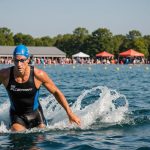Advanced Technique Refinement
Prioritising open water swimming techniques can significantly improve your performance and efficiency. The key elements of stroke technique include maintaining a balanced body position and developing efficient breathing patterns. Unlike in pool swimming, open water requires a higher head position to navigate effectively, helping swimmers spot landmarks and swim straight. Integrating smooth arm recovery and maintaining a steady rhythm are essential for conserving energy over longer distances.
Body positioning is crucial in open water swimming. Swimmers should aim to keep their bodies streamlined, engaging the core to enhance balance and reduce drag. Employing proper sighting techniques—such as lifting the head slightly during a stroke—helps in navigating challenging conditions while staying on course.
Also to see : Boosting your lactate threshold: effective training techniques for endurance enthusiasts
Common technique errors can hinder progress and lead to exhaustion. Over-rotating during strokes or poor breathing patterns often result in fatigue and inefficient swimming. To correct these, swimmers should practice drills focusing on bilateral breathing and efficient arm strokes. Drills can develop muscle memory, ensuring better execution during competitions.
Understanding these elements equips swimmers with necessary strategies to overcome the unpredictable nature of open water environments. As refinement in these areas progresses, performance gains are inevitable, allowing for more enjoyable and successful open water experiences.
Topic to read : Mastering swim strokes: how video analysis transforms performance enhancement for swimmers
Conditioning Workouts for Endurance
Developing endurance requires a strategic approach, especially in the context of open water fitness training. Diversifying your training routine is essential for long-distance swimming. Incorporating a structured workout plan is crucial. These plans often include varied session lengths, intensities, and types of strokes. For instance, alternating between slow, continuous swims and faster interval sessions can efficiently build endurance over time.
Strength training plays a pivotal role in enhancing open water performance. Incorporating exercises like push-ups and pull-ups can augment muscular strength, which is vital for maintaining stroke power and efficiency during prolonged swims. It is recommended that swimmers engage in strength sessions at least twice a week to complement their swimming workout.
Monitoring and boosting cardiovascular capacity is integral to open water fitness success. Swimmers should frequently measure their heart rate during workouts to ensure they are training at the optimal intensity. Using heart rate monitors or manual pulse checks can provide insights into training effectiveness. Gradually increasing the duration or intensity of training sessions helps improve cardiovascular endurance.
By integrating these elements into your regimen, you lay the groundwork for improved endurance. Adapting workouts to include diverse components helps swimmers prepare comprehensively for the open water’s demands.
Race Strategies for Open Water Events
In competitive swimming strategies, pre-race preparation is crucial for success in open water events. Swimmers should focus on both physical and mental readiness. Developing a routine that includes practice swims in similar conditions to the race day can build confidence and improve technique. Mental strategies often involve visualization and setting realistic goals, helping athletes stay focused and calm.
During the race, tactical considerations are vital. Navigating buoys accurately and efficiently can significantly affect performance. Competitors should plan the best route and practice spotting techniques to maintain a straight trajectory. Waves and currents also play a significant role; staying aware of these elements and using them to your advantage can save energy and time. Understanding competitor behaviour is another key aspect. Identifying and adjusting to the pace of surrounding swimmers can be beneficial, particularly when drafting, which involves swimming close behind or beside another swimmer to reduce drag.
Post-race recovery is essential for optimal performance. Implementing techniques like cool-down swims, hydration, and proper nutrition can expedite recovery and prepare the body for future events. Swimmers should also engage in active rest, such as light walking or stretching, to reduce muscle stiffness. Acknowledging the physical and mental exertion of the race ensures readiness for subsequent competitions.
Essential Equipment for Open Water Swimming
Open water gear essentials are crucial for both comfort and safety in the exhilarating world of open water swimming. For elite swimmers, having the right equipment can significantly enhance performance. Key gear includes wetsuits, known for their thermal insulation and buoyancy, which are vital for maintaining warmth and flotation in cold waters. Buoyancy aids not only provide extra floatation but also enhance visibility, ensuring swimmers remain safe and seen by others.
Regular maintenance of this equipment is necessary to ensure durability and effectiveness. After each swim, rinse wetsuits and other gear with fresh water to remove salt or chlorine, which can degrade materials over time. Allow your equipment to dry completely in a shaded area, avoiding direct sunlight that may cause fading or weakening of the fabric.
Storage is also a critical consideration. Ensure wetsuits and other gear are stored flat or hung with broad-shouldered hangers to prevent creases and deformity. Proper gear care extends its life and guarantees that swimmers are always ready for their next aquatic adventure.
Investing in these gear essentials not only prepares swimmers for the challenges of open waters but also provides the confidence needed to excel.
Training Plans and Success Stories
Having the right open water swim training plans can dramatically impact your swimming success. Tailored samples cater to various skill levels, ensuring everyone, from beginners to advanced swimmers, can benefit. These plans typically include a blend of endurance building, speed work, and technique refinement, allowing swimmers to prepare holistically for races or personal goals.
For instance, beginner plans might focus on gradually increasing distance and developing basic skills, while more advanced plans integrate interval training and specific race simulations. The flexibility of these plans allows for easy adaptation based on personalised goals and the natural elements experienced in open water settings.
Revisiting the journeys of elite swimmers provides valuable insights. Many have followed regimented open water swim training plans that are supportive yet demanding. Case studies highlight how elite athletes incorporate rigorous analyses of their performance data, constantly adjusting their training regimens to reflect physical and mental progress.
Training plans must be adaptable. Whether due to injury, unexpected life changes, or even shifting competition formats, understanding how to adjust plans without losing focus is crucial for sustained progress.
Ultimately, success in open water swimming lies in the synergy between structured training, flexibility, and personal commitment.
Mental Preparation for Open Water Swimming
Mental strategies for swimmers are crucial, especially in open water environments where unpredictability reigns. Key techniques for building mental resilience start with structured visualization exercises. Swimmers can enhance their performance by mentally rehearsing every part of the race. By vividly imagining movements, environmental conditions, and overcoming potential obstacles, they create a mental blueprint that prepares them for actual scenarios.
Managing anxiety is another integral component. Swimmers should develop a routine to calm pre-race jitters, such as deep breathing or rhythmic mental counting. This helps maintain focus and control, ensuring anxiety does not overshadow performance. Regular practice of these strategies in training simulates race conditions and enhances overall mental fortitude.
Additionally, cultivating mental resilience involves setting achievable goals and practising positive self-talk. Celebrating small victories fosters a positive mindset, which can be game-changing during races. Furthermore, engaging with the swimming community to exchange stories and tips can provide invaluable support.
Ultimately, these strategies form a holistic preparation approach that encompasses both the mental and physical challenges of open water swimming. With dedication and consistent practice, swimmers can elevate their performance by efficiently managing mental hurdles.











